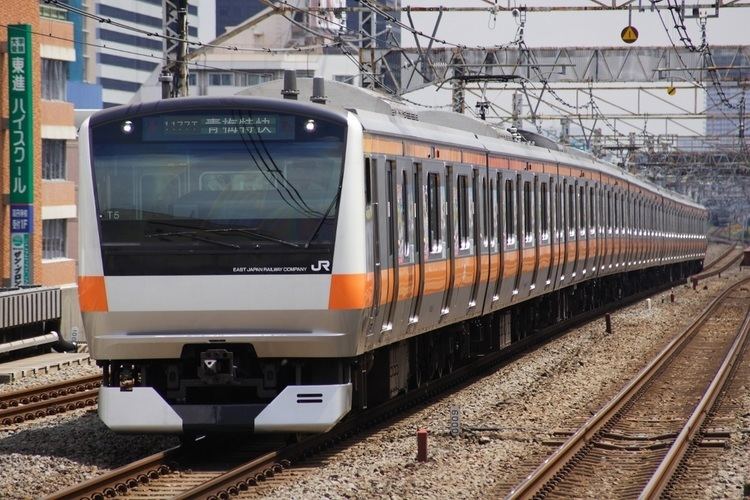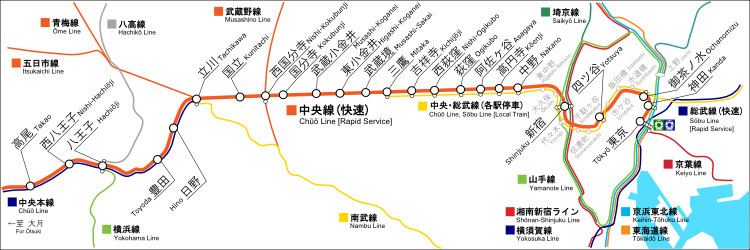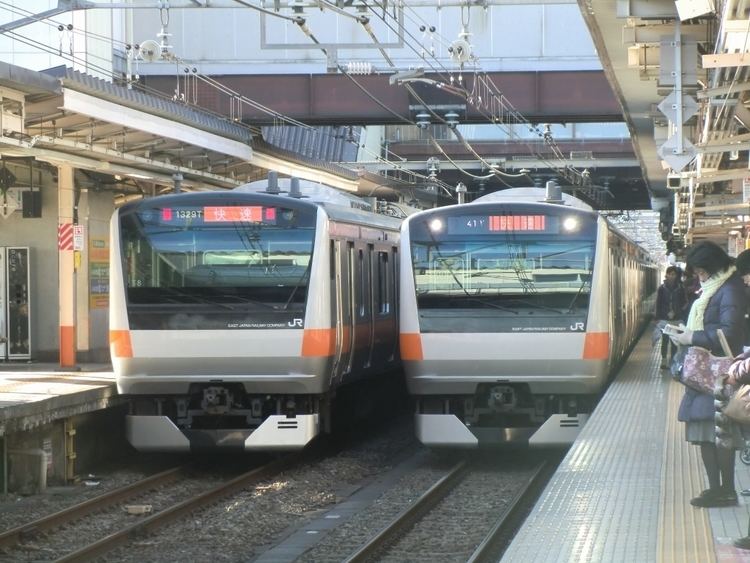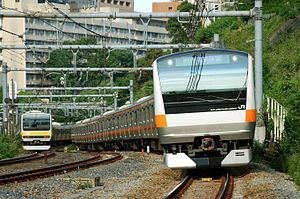Native name 中央線快速 Line length 53.1 km (33.0 mi) | Opened 1932 Rolling stock E233-0 series Track gauge 1,067 mm (3 ft 6 in) Stations 24 | |
 | ||
Operator | ||
Jr ch line rapid driver s view from tokyo to takao in japan
The Chūō Line (Rapid) (中央線快速, Chūō-sen kaisoku) is the name given to rapid services on the eastern section of the Chūō Main Line operated by the East Japan Railway Company (JR East) between Tokyo and Takao stations.
Contents
- Jr ch line rapid driver s view from tokyo to takao in japan
- Basic data
- Services
- Chme Liners
- Rolling stock
- Rolling stock used in past
- History
- Future developments
- High suicide rate
- References

Basic data

Services

Although the Chūō Line (Rapid) designation only refers to the section between Tokyo and Takao stations, many trains continue on past Takao to Ōtsuki. These include both limited express and various special rapid services. For details, see the Chūō Main Line article. In addition, Chūō Line (Rapid) trains do not stop at some stations between Ochanomizu and Nakano stations; for information on those services, see the Chūō-Sōbu Line article.

The Chūō Line (Rapid) uses the two express tracks on the four-track section between Ochanomizu and Mitaka stations. Past Mitaka, trains use both tracks on the remaining double-track section. Since the express tracks do not have platforms at several stations in central Tokyo, even the slowest services of the Chūō Line (Rapid) skip such stations and are therefore called "Rapid" (快速). In addition to the basic type of "Rapid", there are some variations of the service types with fewer stops.


Chūō/Ōme Liners
The Chūō Liner and Ōme Liner services run on weekday peak periods only. There is one Chūō Liner from Takao for Tokyo in the morning and six in the evenings from Tokyo for Takao and Hachioji and in the past terminating in Ōtsuki. The Ōme Liner has one service during the morning from Ōme and two in the evening from Tokyo. Unlike other rapid services, the Chūō/Ōme Liners require the purchase of a liner ticket in addition to the base fare; all seats are unreserved, but the number of liner tickets sold is limited to the number of seats available. Liner services are provided by E257 series 11-car or 9-car EMUs (introduced in July 2002) and E351 series 12-car EMUs (introduced in March 2008).
Chūō Liners stop at: Tokyo - Shinjuku - Tachikawa - Hachiōji - (Takao) Ōme Liners stops at: Tokyo - Shinjuku - Tachikawa - Haijima - Kabe - Ōme
Rolling stock
Rolling stock used in past
History
Most of the route of the Chūō Line (Rapid) was built by the Kōbu Railway and later acquired by the Japanese Government Railways in 1906.
Operation of electric multiple unit (EMU) trains on the Chūō Main Line began in 1904. By 1930, the EMU service had reached Tokyo to the east and Asakawa (now Takao) to the west. In 1933, two tracks were added to the existing double-tracked section between Ochanomizu and Iidamachi stations (later closed) to complete the four-track line between Ochanomizu and Nakano. On these additional tracks, express trains (急行電車, kyūkō densha), which skipped all stations except Yotsuya and Shinjuku, were introduced the same year. The express service was renamed "Rapid" (快速, kaisoku) service in March 1961.
Initially, the operation of express/rapid services was limited to weekday peak periods only. Express service began on weekends on March 5, 1944; daytime non-peak operation began on November 9, 1959, but it was limited to weekdays only until April 28, 1966.
Manseibashi Station, located between Kanda and Ochanomizu, was closed in 1943. On the section east of Takao, only Nishi-Kokubunji Station (opened in 1973) and Nishi-Hachiōji Station (opened in 1939) were opened after the start of rapid services.
Future developments
In February 2015, JR East announced plans to introduce Green (first class) cars on Chuo Line (Rapid) and Ome Line services from fiscal 2020. This will involve adding two bilevel Green cars to 10-car E233 series EMU sets, forming 12-car sets. Work will be involved in lengthening station platforms and depot facilities to handle the longer trains.
High suicide rate
The Chuo Rapid Line is known for a high number of suicides, primarily due to the high speed at which some trains pass through stations on the line.
